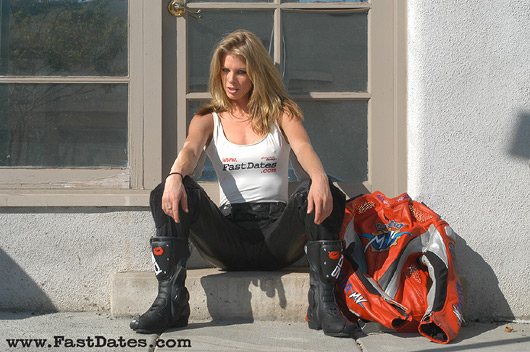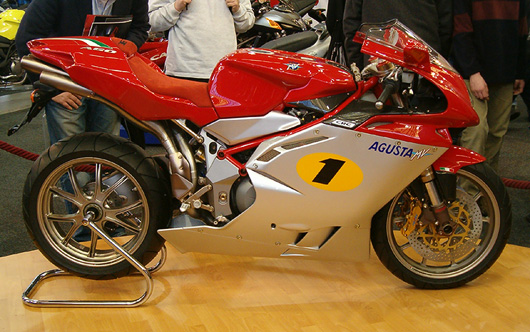|

The
F4 Mille is not the only fancy Italian playboy that Robin, former
Miss Texas and Hawaiian Tropic International Swimsuit Pageant
winner, has had the chance to evaluate. She also test the Ducati
999R05 for us.
MV
Agusta 2005 F4 1000 -page 2
Twising
the Throttle
The stock F4-1000 has already been doing well in 5-bike shootouts
in the European magazines against the current crop of 2004 Japanese
1000cc Superbikes, both in the handling and performance departments.
What the Mamba Kit addresses is the F4s only significan fault,
it's big pasta belly 423 lb dry weight. The Mamba kit with its
lighter forged wheels and carbon fibre bodywork susposedly drops
the bike down to the 399 lb. contender weight category where it
should be, now giving it a marked advantage advsange when comparing
it to the Japanese competition.
We
also had the opportunity to get in about 30 minutes of saddle
time on the special edition F4 1000 Ago which
was graciously loaned to us by Italina sportbike owner and enthusiat
Cammie Coe, who received the first Ago on the West Coast in November.
In our minds the Ago's Red / Silver livery is the only correct
color for the MV as it pays historical tribute the original colors
of former World Champion Giacomo Agostini's winning MV in-line
four grand prix racer from the late 1960's - early 1970's. The
Ago gets much of the same carbon fibre bodywork found the Mamba
kit, along with the lighter forged Marchesini wheels, and a slight
power upgrade and weight reduction with the slip-on Race Silencer
Kit at the rear and an EPROM chip upgrade. Priced at just $24,995
the Ago is a bargain compared to the pricier Mamba Kit without
the Race Silercer Kit. Unfortuately, all Ago's were pretty much
presold, with Cammie having ordered his almost 2 years earlier.

The
F4 1000 Ago -talk about a Hollywood trophy wife, the looks alone
are worth the price of admission. The red suede leather saddle
could makle a girl cream in her jeans.
The
F4 Mille (Mille means l000(cc) for those of you who don't know
Italian) is a big, top heavy brute when it came to this girl pushing
it around on the street for our photos, even in the 15-20 lb.lighter
Mamba and Ago versions. Climbing on board is also a difficult
proposition as this bike is extreamely tall, even more so than
other current open class superbikes .It's akin to getting on a
long suspenion dual purpose bike. Once in the saddle myfeet's
reach to the ground with a 34' inseam was still on tip toes and
the fear of dropping the Italian Stallion was always foremost
in my mind.
Once
rolling and under power the F4 Mille feels very similar to the
iconic Italian bike handling of Tambourini's previous masterpiece,
the Ducati 916 Superbike. In fact, it feels and handles very much
like the 916 since the F4 was the first bike Tambourini designed
after leaving Ducati. Unfortunately, he had to contend with stuffing
a much larger, taller, and top heavy inline-four cylinder lump
in a space previously occupied by a slender and lower V-twin.
As a result the F 4 Mille feels much like a 916, but it is physically
taller and much more top heavy with the upright 4 cylinders and
their accompanying valve gear.
This
is despite the fact the new 1000cc engine design has been lightened
internally considerbly with lighter pistons, camshafts and such
compared to the initially designed F4 750 to modernize the engine
and allow it to rev quicker and higher for even better performance
than just a 250cc displacement increase. Hopefully the 750cc version
will reap thesame lightening and performance gains of its new
big brother in the near future.
The
chassis geometry is quick, nimble and precise on the Mille just
like Tambourini's 916, but you've got that taller height and all
that weight to contend with. On tighter canyon roads like the
switchbacks of Latigo or above the Rock Store on Mullholand, the
bike is not fun. It is just too tall and bulky and it takes a
lot of effort and concentration to manage all that weight and
height. Just the week before we had taken a current '04 Honda
CBR1000RR down the same roads and the Honda was much more noticeably
smaller, lighter and easier to handle.
With
those beautiful gold 6-piston Nissin brake calibers hanging off
the front of the Ago's beefy Marzocchi 50mm forks I expected some
pretty impressing stoping performace, but the brakes on our Ago
were nearly unuseable. Each application of the front binders provided
almost no stopping power whatsoever, and it would take nearly
a full second of dragging the brakes to get them to heat up enough
to finally bite, and which point they did do their job very well.
Bike owner Cammie warned us of the problem before we took the
bike out, and he said different compound pads were on their way
from Italy to correct the problem. Typical exotic Italian superbike
hassles from never having tested the brake pad compound compatability
with the brake rotors used on the Ago. Unfortunately, I wasn't
be able to stuff the Ago hard into any corners no knowing when
the pads would finally bite.
Both
ends of the Ago were extreamly stiff, which is close to how I
like by own bike's suspension setup for better control, but with
the Mille's mass it did need to be softer . At high speed the
suspension felt much better, but it still needed to be dialed
in for the street, which requires lots of time and patience and
possibly a race track, all of which I didn't have for my ride.
Once
the canyons opened up and I got into sweepers above 60 mph/100
kph the Mille feels much better. The top heavy feeling receeds
and the bike's sheer bulk helps keep it more stable and secure,
together with its very stiff suspension, both front and rear.
The Mille above 80 mph now maneuvers more easily like a 600cc
class sportbike, but you are still somewaht daunted by being positioned
in the seat so so high above the ground. The F4 is very agressive
and precise when it comes to picking lines and moving around in
a corner, but it is handicaped by its sheer bulk and the rider's
height perchedon top of it.
As
the pavement opens up and it becomes time to start wicking the
power on.... Whoa Daddy! Then you can really appreciate the Ago's
big bike power as it explodes down the pavement. The remapped
and repipped Ago we spent most of our time on was really scarry
strong. Pulling like it was supercharged from about 4,000 rpm
and really comming on tap at 7,000. The roads were to tight to
get it much above 100 mph anywhere, and the power was just too
strong too rev it out hard in any gear. The power is very linear
and turbine smooth, but as it rushes above 8,000 you really do
need to be on a race track as it becomes very intimidating, very
fast.
In
comparison to the old MV F4 750, the new 1000 not only has significantly
more power, but 50% more torque which makes you very wary at first
when it comes to feeding on the gas. But once use to it, the power
is much more friendly and useable than the Open class Japanese
bikes. The stock '04 Honda CBR1000RR which is the closest in performance,
is just dead in the mid drange in comparison. While the R1 Yamaha
doesn't start to come on strong until until about 7,000rpm. But
that's not to say the Honda and the other jap bikes couldn't be
dialed up as well with a full race pipe system and a computer
remapp, and for a lot less money. Plus, the latest generationJapanese
superbikes are much smaller, lighter bikse, better suited for
all around sportbike riding.
The
F4-1000's power deliver really impresses for its 164hp, and the
lighter Mamaba chassis kit helps to make it shine. For MV customers
wanting more power (I can't imagine why!) there will be the Tamburini
version of the engine, available in the upcoming Tamburini and
Corsa (track only, no lighting) special editions, which bump the
power up to 176hp with patented variable length intake stacks
and a race tuned exhasut system and matching ECU. Here you'll
find an extra kick of top end power coming on around 9,500rpm
and pulling you along strongly when the soft rev limiter kicks
in at 13,000. I know I'm almost there, enjoying the rush, as the
dash shifter light winks at me at 12,500.
And
how does the 2005 MV Mille, and in particualar the Ago we spent
the most time on, compare to its main Italian rivals the new 2005
Ducati 999 base, S and R models? For design, looks, finish quality
and exclusitivity the MV Agusta is the hands down winner. If I
owned one I'd park it inside my living room and get off on it
twice a day.
But
sportbikes are for riding, and beauty for a superbike needs to
be more than skin deep. The new Ducati 999s may be crude and raw
in comparision, but the Ducati remains in another class by itself
when it comes to riding. Nothing compares to the Ducati Testastretta
engine's strong, user friendly power. The 999 V-twin power is
there instantly at any RPM, easy to contol and ready to pull you
through any corner and catapult you onto the next straight. The
Mille needs time to spool-up before it scares you with its sheer
power. Handling wise, the Ducati remains unmatched as the most
functional, confidence inspiring superbike ever built. A bike
which you feel directly part of and which anticipates every move
for you, whether you are thinking of it or not.
Pierre
Treblanch at Ducati had the advantage of taking Tambourini's landmark
916 design (on which the F4 was cast) and Terblanch improved on
it further my lowering the seat height for better rider control,
comfort and agility, and he increasing the swingarm length for
improved stability. While the F4 required Tambourini to comproimise
on his masterpiece in order to fit in the bulkier, taller MV engine.
Compared to the Ducati, or the new crop of Japanese downsized
lightweight superbikes, the F4 Mille's design is 2 generations
behind.
That
said, the MV Agusta is one of the most beautiful superbike creations
on earth. If your a lover, not a fighter, like a lot of exotic
bike collectors are, the F4 Mille and its limited edition versions
like the Mamba, Ago and future editions will be the showpeice
of your collection. Cio baby! XOXOX, Robin.
Underseat
quad exhausts, single side swingarm, nice ass..... reminicent
of Tamburini's 916 Ducati.

|
